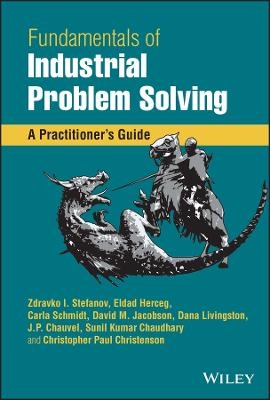
Fundamentals of Industrial Problem Solving
John Wiley & Sons Inc (Verlag)
978-1-119-54318-3 (ISBN)
As modern industrial processes have become increasingly complex, complicated multi-factor problems have emerged. These complex problems end up costing companies millions of dollars every day. Existing problem-solving techniques are only effective to a certain point. This book provides a solution to a myriad of industrial problems by using first principles and rigorous hypothesis testing. Key topics covered within the work include:
How to use the latest research, advanced modeling, big data mining, analytical testing, and many other techniques to systematically create and test hypotheses surrounding why a process is malfunctioning
How to use scenario development to frame a team’s understanding of why a process is malfunctioning
How to approach today’s lack of experienced industrial workers, whose failure to approach problem solving from first fundamentals are causing myriad of inefficiencies in industry
How to use multiple methodologies together with an emphasis on first principles and mechanistic math modeling as a basis to industrial problem solving
Engineers of any discipline working in both research and development of manufacturing environments, along with professionals in any industrial discipline looking to reduce costs will be able to use this work to both understand and pragmatically solve the pressing issues we see in today’s industrial market.
Zdravko I. Stefanov PhD (Texas Tech University) is an experienced problem solver with 20 years of demonstrated history of working in the pulp & paper and the chemicals industry. He has extensive experience in chemical engineering, multivariate data analysis, advanced process control and continuous improvement. Eldad Herceg PhD (University of Illinois) is an accomplished industrial problem solver and holds experience in applied Quantum Mechanics with an emphasis on solid-state chemistry and processes. Carla Schmidt PhD (University of Texas) began her career in 1998. As a Fundamental Problem Solver, she uses analytical chemistry to identify the root causes of manufacturing and R&D problems such as fouling, corrosion and trace chemistries that lead to color and odor issues. David M. Jacobson is a University of Kansas BS Chem. Engr. with 32 years in the chemical industry and certifications in Six Sigma Master Blackbelt, Lean, and now working in Fundamental Problem Solving. Dana Livingston is a University of Wyoming B.S Ch,E.1980 and University of California, Hass MBA 1990 with 42 years at The Dow Chemical Company and Corteva Agriscience working on complex projects in manufacturing and process development. J.P. Chauvel, Jr PhD (University of California) has worked at Dow Chemical in many roles for over 30 years, focusing on problem solving in manufacturing processes. Sunil Kumar Chaudhary, PhD (Lucknow University, India) worked in Analytical Sciences and Analytical Technology Center at the Dow Chemical Company for 30 years, leading large multidisciplinary complex projects and teaching the next generation of problem solvers. Christopher Paul Christenson had a distinguished four-decade career with The Dow Chemical Company as a Corporate Fellow.
1. Introduction 6
2. First Principles Problem Solving – why first principles? 15
3. Opportunity identification/definition – initial team formation 35
4. Hypothesis testing 46
5. Scenario development 56
6. Value of project 57
7. Team management and roles 61
8. Stakeholder Identification, Analysis, and Communication plan 94
9. Generating, Selecting, and Implementing Solutions to the Problem 151
10. Sustaining the Gains and Control plans 190
11. Project Wrap-up 221
12. The big world of problems 224
13. Corrosion problems 236
14. Mechanical issues 239
15. Color 247
16. Emphasis is on speed, low cost, productivity and right answer 256
17. Literature 258
18. Scientific Method 263
19. Process Data Analysis 265
20. First Principles Modeling 283
21. Analytical 296
22. Engineering disciplines examples 309
23. Six Sigma, LEAN and Continuous Improvement 315
24. Theory of Constraints 326
25. Visual presentation 339
Appendix
1. Scientific Method Practice Levels 346
| Erscheinungsdatum | 17.08.2022 |
|---|---|
| Verlagsort | New York |
| Sprache | englisch |
| Maße | 10 x 10 mm |
| Gewicht | 454 g |
| Themenwelt | Naturwissenschaften ► Chemie ► Technische Chemie |
| Technik ► Maschinenbau | |
| ISBN-10 | 1-119-54318-5 / 1119543185 |
| ISBN-13 | 978-1-119-54318-3 / 9781119543183 |
| Zustand | Neuware |
| Informationen gemäß Produktsicherheitsverordnung (GPSR) | |
| Haben Sie eine Frage zum Produkt? |
aus dem Bereich


